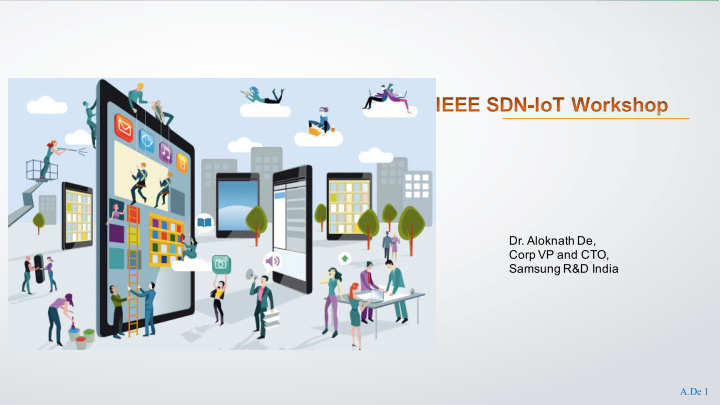



Dr. Aloknath De, Corp VP and CTO, Samsung R&D India A.De 1
Internet of Things – Introduction The Internet of Things (IoT) is the network of physical objects that contains embedded technology to communicate and sense or interact with the objects' internal state or the external environment.* *Gartner, July 2014
IoT Business Opportunity Predicted revenue verticals Interoperability required to capture 40% of • total value < 1% of data from devices or sensors currently • used (more can be used for optimization & prediction ) IoT Units Installed Base by Category Category 2015 2016 2020 Consumer 3023 4024 13509 Business Cross Industry 815 1092 4408 Business: 1065 1276 2880 Vertical-Specific Grand Total 4902 6392 20797 A.De 3 *Source: Mckinsey Report – June 2015 / Gartner Report – Nov 2015
IoT Players in the Value Chain – Industry Trends Industry leaders from various verticals focus on IoT as their next revenue model Tiny chipsets, low-power connectivity, LTE deployment and cloud infrastructure speeds- up IoT deployment 4
IoT Consortiums Landscape v Connectivity Standard for P2P & Group communication based on Open v Open Source Implementation for Standards. P2P & Point to Multi Point communication based on D-Bus architecture Thread by Google - Mesh Networking standard for IEEE 802.15.4 for Standard to connect devices seamlessly at home & corporate Connected Home scenarios environment v Focuses on creating frameworks, use cases & test beds for real-world apps across various industrial environments v Address need for a common v Alliance seeking to establish IP M2M Service Layer that can as basis for connection of be readily embedded within Smart Objects various hardware and software A.De 5
Open Interconnect Consortium Evolved to Open Connectivity Foundation (OCF) A.De 6
IoTivity Technology Stack – Technical View IoT Profiles v Common Solution Consumer Enterprise Industrial Automotive Health v Established Protocols v Security & Identity IoT Framework v Standardized Profiles v Interoperability Data Device Data v Innovation Opportunities Discovery Transmission Management Management v Necessary connectivity Security IoT Connectivity A.De 7
IoTivity Topologies Supported OIC Client OIC Server OIC Client OIC Client XMPP/ P2P Direct STUN/ TURN/ICE OIC Intermediary Cloud Gateway Gateway OIC Servers Smart Device Remote Access Smart Appliance OIC Servers Cloud based intelligent Services Sensors, Wearables A.De 8
Key Standards used in IoTivity Apps Apps Application CoRE OCF CoRE Presentation Layer CoAP CoAP Session Layer 6LoWPAN for BT LE UDP UDP Transport Layer BT LE L2CAP IPv6 IPv6/6LoWPAN Network Layer Thread BT LE Link Layer 6LoWPAN BT 4.2 Link Layer MAC BT LE Physical Physical Layer LLN Phy BT 4.2 (Supports Only Star & TCP/IP OSI Model Mesh is under progress) Apps mapping on OSI CoRE IEEE 802.2 LLC/Other *LLN – Low Power CoAP LLC Lossy Networks UDP IEEE 802.15.4 MAC IPv6/6LoWPAN IEEE 802.15.4 PHY 868/915/2400 MHz IEEE 802.15.4 Network Topology IEEE 802.15.4 LLN 9 (Supports both Star & Mesh)
What’s hindering IoT? Fragmentation Software, Services and Algorithms Multiplicity of standards Lack of open IP-Based Connectivity No cross-industrial standard / reference design Delay in IPv6 deployment Interoperability issues at different levels of Low Power “Self-healing sensor Network” software and hardware Efficient protocol and topology to form Heterogeneous Mesh Networks Creating flexible and scalable systems Security & Privacy Secure and authorized access IPv Privacy of User Data Models for decentralized authentication Data integrity at consumer devices Collective Intelligence Device & Data Management Seamless plug-n-play of sensor nodes Individual nodes and sensors may not be Managing millions of connected smart objects & “Smart” enough real time event handling Need to leverage big data and cluster of sensors/device to bring in collective intelligence Handling the huge data generated by IoT devices A.De 10
Software-Defined Networking (SDN) to IoT Separation of Control and Data Plane Heterogeneity in IoT Networks Network controlled by SW Applications; suitable Lack of open IP-Based Connectivity; delay in IPv6 backbone for mobile network deployment Uses general purpose hardware and commodity Efficient protocol and topology to form Heterogeneous servers Mesh Networks Enables automated, policy-based control of even Objects and protocols have specific design; forcing them to massive network fit with common and singular protocol not good option. Abstraction of Network Devices Not reference by individual devices IPv Plug-and-play set up of IoT devices Automatic remediation of security threats Software-defined things (SDT) Edge Computing and Analytics Server Virtualization and Connections Individual nodes and sensors potentially could generate tons of data Cloud network; one server acting as multiple servers Provisioning of edge computing/analytics turn Architecture for network OS with service/application data into insights oriented namespace Between server: east-west traffic 11
Summary: SDN Benefits to IoT Data Modeling and Parameters Connectivity, Robustness Real-time, Delay, Jitter, QoS Security, Reliability Dynamic Load Management: This enables operators to monitor and orchestrate automatic changes in bandwidth given overall network load. Ideal for global IoT providers readying for exponential increases in devices and data. Service Chaining: This enables operators to provision virtual security features like VPNs, firewalls and authentication and fix policy tolerances for performance in line with given subscriber’s entitlements. Also, distribution possible for NAT, DPI, Access control etc. Bandwidth Calendaring: This allows operators to schedule when and how much traffic a customer or application will need at specific time. Applicable to IoT services as many devices send data periodically only. 12
Recommend
More recommend